Bounded Rationality, Social Capital and Technology Adoption in Family Farming: Evidence from Cocoa-Tree Crops in Ivory Coast
Abstract
:1. Introduction
2. Context and Preliminary Raw Data on Yield, Inputs, Productivity Growth, and the Tree Life Cycle
2.1. Data
2.2. Changes in Farming Practices, Yield, and Productivity Growth
2.3. Changes in Farming Practices and the Life Cycle of the Tree
3. Preliminary Evidence for a Status Quo Bias in Decision-Making
3.1. External Constraints versus Cognitive Scarcity
3.1.1. External Constraints: Lack of Resources and Informational Inefficiencies
3.1.2. Limited Cognitive Capabilities: Satisficing, Tradition, Habit, and Imitation
3.2. Reasons for Adopting a Proactive Behavior
3.3. Farmers’ Socioeconomic Characteristics, Plantation Size and Yield, and the Status Quo
3.4. External Constraints, Cognitive Scarcity, and Productivity
4. Civic Capital, Group Membership, and Information Exchange
4.1. Civic Capital Space: Solidarity, Reciprocity, Trustworthiness, and Cooperation
“The social world can be represented as a space (with several dimensions) constructed on the basis of principles of differentiation or distribution constituted by the set of properties active within the social universe in question. [...] Agents and groups of agents are thus defined by their relative positions within that space.”
4.2. Structural Social Capital: Group Membership and Information Sharing
5. Social Capital and Status Quo versus Proactive Behavior
6. Conclusions
Author Contributions
Funding
Institutional Review Board Statement
Informed Consent Statement
Data Availability Statement
Acknowledgments
Conflicts of Interest
References
- Aneani, F.; Ofori-Frimpong, K. An analysis of yield gap and some factors of cocoa (Theobroma cacao) yields in Ghana. Sustain. Agric. Res. 2013, 2, 117–127. [Google Scholar]
- Wessel, M.; Foluke Quist-Wessel, P.M. Cocoa production in West Africa, a review and analysis of recent developments. NJAS Wagening. J. Life Sci. 2015, 74–75, 1–7. [Google Scholar] [CrossRef] [Green Version]
- Jack, B.K. Market Inefficiencies and the Adoption of Agricultural Technologies in Developing Countries; CEGA White Papers: Berkeley, CA, USA, 2013. [Google Scholar]
- Mwangi, M.; Kariuki, S. Factors determining adoption of new agricultural technology by smallholder farmers in developing countries. J. Econ. Sustain. Dev. 2015, 6, 208–216. [Google Scholar]
- Simon, H.A. A behavioral model of rational Choice. Q. J. Econ. 1955, 69, 99–118. [Google Scholar] [CrossRef]
- Simon, H.A. Rational choice and the structure of the environment. Psychol. Rev. 1956, 63, 129–138. [Google Scholar] [CrossRef] [Green Version]
- Gigerenzer, G.; Selten, R. Rethinking rationality. In Bounded Rationality: The Adaptive Toolbox; Gigerenzer, G., Selten, R., Eds.; The MIT Press: Cambridge, MA, USA, 2001. [Google Scholar]
- Kremer, M.; Rao, G.; Schilbach, F. Behavioral development economics. In Handbook of Behavioral Economics; Bernheim, D., Della Vigna, S., Laibson, D., Eds.; Elsevier: Amsterdam, The Netherlands, 2019; Volume 2. [Google Scholar]
- Datta, S.; Mullainathan, S. Behavioral design: A new approach to development policy. Rev. Income Wealth 2014, 60, 7–35. [Google Scholar] [CrossRef]
- World Development Report. Mind, Society, and Behavior; World Bank Group: Washington, DC, USA, 2015. [Google Scholar]
- Munshi, K. Community networks and the process of development. J. Econ. Perspect. 2014, 28, 49–76. [Google Scholar] [CrossRef] [Green Version]
- Coleman, J.S. Social capital in the creation of human capital. Am. J. Sociol. 1988, 94, S95–S120. [Google Scholar] [CrossRef]
- Bowles, S.; Gintis, H. Social capital and community governance. Econ. J. 2002, 112, F419–F436. [Google Scholar] [CrossRef]
- Guiso, L.; Sapienza, P.; Zingales, L. Civic capital as the missing link. In Handbook of Social Economics; Benhabib, J., Bisin, A., Jackson, M.O., Eds.; Elsevier: Amsterdam, The Netherlands, 2011. [Google Scholar]
- Dasgupta, P. Economic progress and the idea of social capital. In Social Capital: A Multifaceted Perspective; Dasgupta, P., Serageldin, I., Eds.; The World Bank: Washington DC, USA, 2000. [Google Scholar]
- Durlauf, S.N.; Fafchamps, M. Social capital. In Handbook of Economic Growth; Aghion, P., Durlauf, S.N., Eds.; Elsevier: Amsterdam, The Netherlands, 2005. [Google Scholar]
- Fehr, E. On the economics and biology of trust. J. Eur. Econ. Assoc. 2009, 7, 235–266. [Google Scholar] [CrossRef] [Green Version]
- Portes, A. Social capital: Its origins and applications in modern sociology. Annu. Rev. Sociol. 1998, 24, 1–24. [Google Scholar] [CrossRef] [Green Version]
- Granovetter, M.S. Economic action and social structure: The problem of embeddedness. Am. J. Sociol. 1985, 91, 481–510. [Google Scholar] [CrossRef]
- Demeritt, A.; Hoff, K. The making of behavioral development economics. Hist. Political Econ. 2018, 50, 303–322. [Google Scholar] [CrossRef]
- Grootaert, C.; Van Bastelaer, T. Understanding and Measuring Social Capital; The World Bank: Washington, DC, USA, 2002. [Google Scholar]
- Grootaert, C.; Narayan, D.; Jones, V.N.; Woolcock, M. Measuring Social Capital: An Integrated Questionnaire; World Bank Working Paper No. 18; World Bank: Washington, DC, USA, 2004. [Google Scholar]
- Simon, H.A. Models of Man, Social and Rational: Mathematical Essays in on Rational Human Behaviour; Wiley: New York, NY, USA, 1957. [Google Scholar]
- Rubinstein, A. Modeling Bounded Rationality; The MIT Press: Cambridge, MA, USA, 1998. [Google Scholar]
- Granovetter, M.S. The strength of weak ties. Am. J. Sociol. 1973, 78, 1360–1380. [Google Scholar] [CrossRef] [Green Version]
- Bros, C.; Desdoigts, A.; Kouadio, H. Land tenure insecurity as an investment incentive: The case of migrant cocoa farmers and settlers in Ivory Coast. J. Afr. Econ. 2019, 28, 147–175. [Google Scholar] [CrossRef]
- Haushofer, J.; Fehr, E. On the psychology of poverty. Science 2014, 344, 862–867. [Google Scholar] [CrossRef] [PubMed]
- Schilbar, F.N.; Schofield, H.; Mullainathan, S. The psychological lives of the poor. Am. Econ. Rev. 2016, 106, 435–440. [Google Scholar] [CrossRef] [Green Version]
- Guirkinger, C.; Platteau, J.-P.; Goetghebuer, T. Productive inefficiency in extended agricultural households: Evidence from Mali. J. Dev. Econ. 2015, 116, 17–27. [Google Scholar] [CrossRef]
- Takahahi, K.; Muraoka, R.; Otsuka, K. Technology adoption, impact, and extension in developing countries’ agriculture: A review of the recent literature. Agric. Econ. 2020, 51, 31–45. [Google Scholar] [CrossRef]
- Foster, A.D.; Rosenzweig, M.R. Learning by doing and learning from others: Human capital and technical change in agriculture. J. Political Econ. 1995, 103, 1176–1209. [Google Scholar] [CrossRef]
- Shiferaw, B.; Kebede, T.; Kassie, M.; Fisher, M. Market imperfections, access to information and technology adoption in Uganda: Challenges of overcoming multiple constraints. Agric. Econ. 2015, 46, 475–488. [Google Scholar] [CrossRef]
- Bandiera, O.; Razul, I. Social networks and technology adoption in Northern Mozambique. Econ. J. 2006, 116, 869–902. [Google Scholar] [CrossRef] [Green Version]
- Conley, T.; Udry, C. Learning about a new technology: Pineapple in Ghana. Am. Econ. Rev. 2010, 100, 35–69. [Google Scholar] [CrossRef] [Green Version]
- Wossen, T.; Berger, T.; Di Falco, S. Social capital, risk preference and adoption of improved farm land management practices in Ethiopia. Agric. Econ. 2015, 46, 81–97. [Google Scholar] [CrossRef]
- Duflo, E.; Kremer, M.; Robinson, J. Nudging farmers to use fertilizer: Evidence from Kenya. Am. Econ. Rev. 2011, 101, 2350–2390. [Google Scholar] [CrossRef] [Green Version]
- Hanna, R.; Mullainathan, S.; Schwartzstein, J. Learning through noticing: Theory and evidence from a field experiment. Q. J. Econ. 2014, 129, 1311–1353. [Google Scholar] [CrossRef] [Green Version]
- De Janvry, A.; Sadoulet, E.; Suri, T. Field experiments in developing country agriculture. In Handbook of Field Experiments; Banerjee, A.V., Duflo., E., Eds.; Elsevier: Amsterdam, The Netherlands, 2017; Volume 2. [Google Scholar]
- Fenske, J. L’Étranger: Status, property rights, and investment incentives in Côte d’Ivoire. Land Econ. 2010, 86, 621–644. [Google Scholar] [CrossRef]
- Fenske, J. Land tenure and investment incentives: Evidence from West Africa. J. Dev. Econ. 2011, 95, 137–156. [Google Scholar] [CrossRef]
- Samuelson, W.; Zeckhauser, R. Status quo bias in decision making. J. Risk Uncertain. 1988, 1, 7–59. [Google Scholar] [CrossRef]
- Tversky, A.; Kahneman, D. Belief in the law of small numbers. Psychol. Bull. 1971, 76, 105–110. [Google Scholar] [CrossRef] [Green Version]
- Gigerenzer, G. The adaptive toolbox. In Bounded Rationality: The Adaptive Toolbox; Gigerenzer, G., Selten, R., Eds.; The MIT Press: Cambridge, MA, USA, 2001. [Google Scholar]
- Anderson, J.; Feder, G. Agricultural extension. In Handbook of Agricultural Economics, 3rd ed.; Evenson, R., Pingali, P., Eds.; Elsevier: Amsterdam, The Netherlands, 2007. [Google Scholar]
- Cunguara, B.; Moder, K. Is agricultural extension helping the poor? Evidence from rural Mozambique. J. Afr. Econ. 2011, 20, 562–595. [Google Scholar] [CrossRef]
- Schwartz, B.; Ward, A.; Lyubomirsky, S.; Monterosso, J.; White, K.; Lehman, D.R. Maximizing versus satisficing: Happiness is a matter of choice. J. Personal. Soc. Psychol. 2002, 83, 1178–1197. [Google Scholar] [CrossRef]
- Kahneman, D.; Tversky, A. On the psychology of prediction. Psychol. Rev. 1973, 80, 237–251. [Google Scholar] [CrossRef] [Green Version]
- Kugler, T.; Kausel, E.; Kocher, M. Are groups more rational than individuals? A review of interactive decision making in groups. Wiley Interdiscip. Rev. Cogn. Sci. 2012, 3, 471–482. [Google Scholar] [CrossRef] [PubMed] [Green Version]
- Le Roux, B.; Rouanet, H. Geometric Data Analysis; Kluwer Academic Publishers: Dordrecht, The Nederlands, 2004. [Google Scholar]
- Bourdieu, P. La Distinction; Les Éditions de Minuit: Paris, France, 1979. [Google Scholar]
- Bourdieu, P. The social space and the genesis of groups. Inf. Int. Soc. Sci. Counc. 1985, 24, 195–220. [Google Scholar] [CrossRef]
- Thuo, M.; Bell, A.A.; Bravo-Ureta, B.E.; Lachaud, M.A.; Okello, D.K.; Okoko, E.N.; Kidula, N.L.; Deom, C.M.; Puppala, N. Effects of social network factors on information acquisition and adoption of improved groundnut varieties: The case of Uganda and Kenya. Agric. Hum. Values 2014, 31, 339–353. [Google Scholar] [CrossRef]
- Wooldridge, J.M. Introductory Econometrics: A Modern Approach, 5th ed.; South-Western, Cengage learning: Mason, OH, USA, 2012. [Google Scholar]
- Abadie, A.; Athey, S.; Imbens, G.W.; Wooldridge, J. When Should You Adjust Standard Errors for Clustering? NBER Working Paper 24003; NBER: Cambridge, MA, USA, 2017. [Google Scholar]
- Olivier de Sardan, J.-P. Anthropologie et Développement; Karthala: Paris, France, 1995. [Google Scholar]
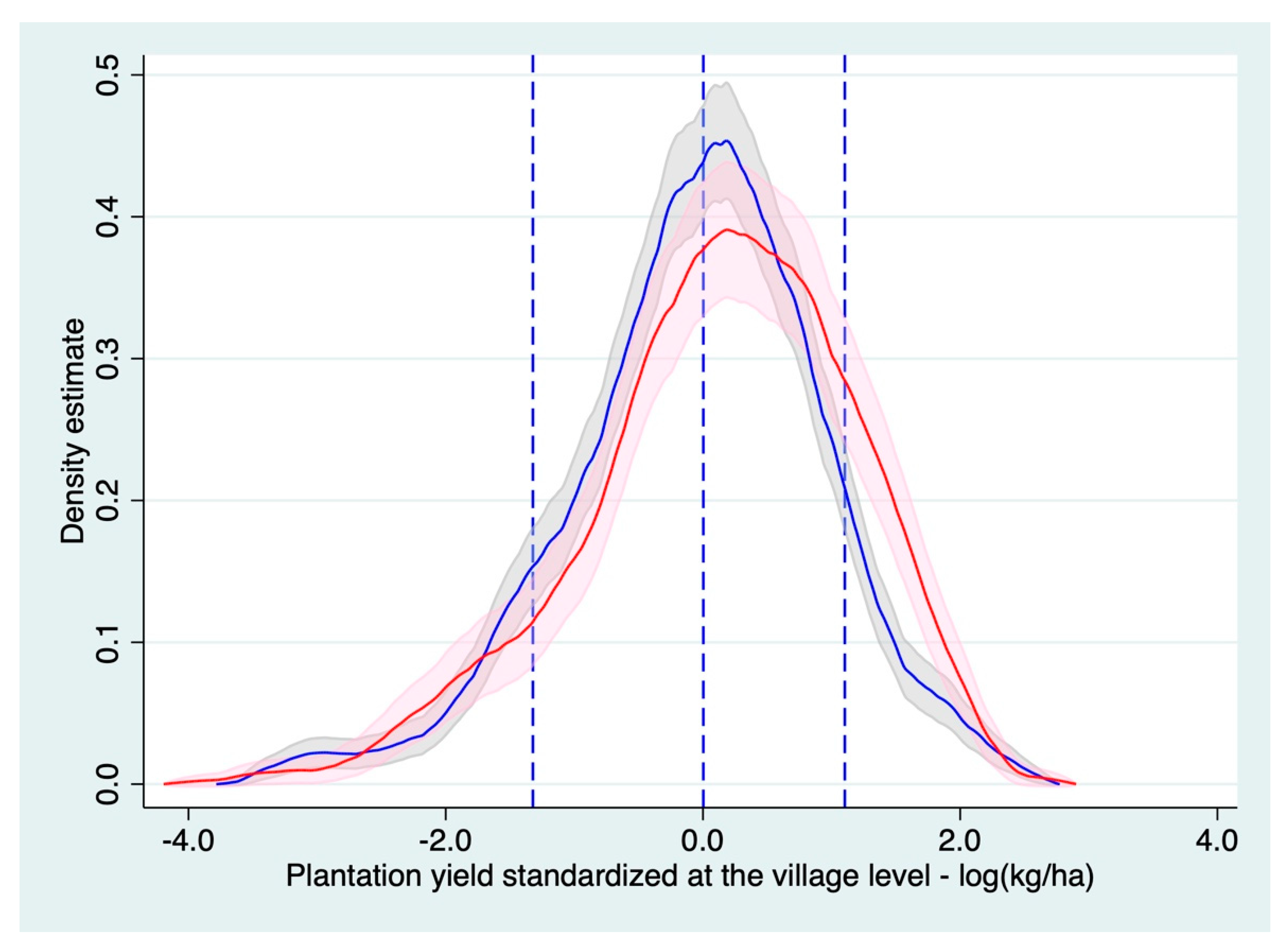
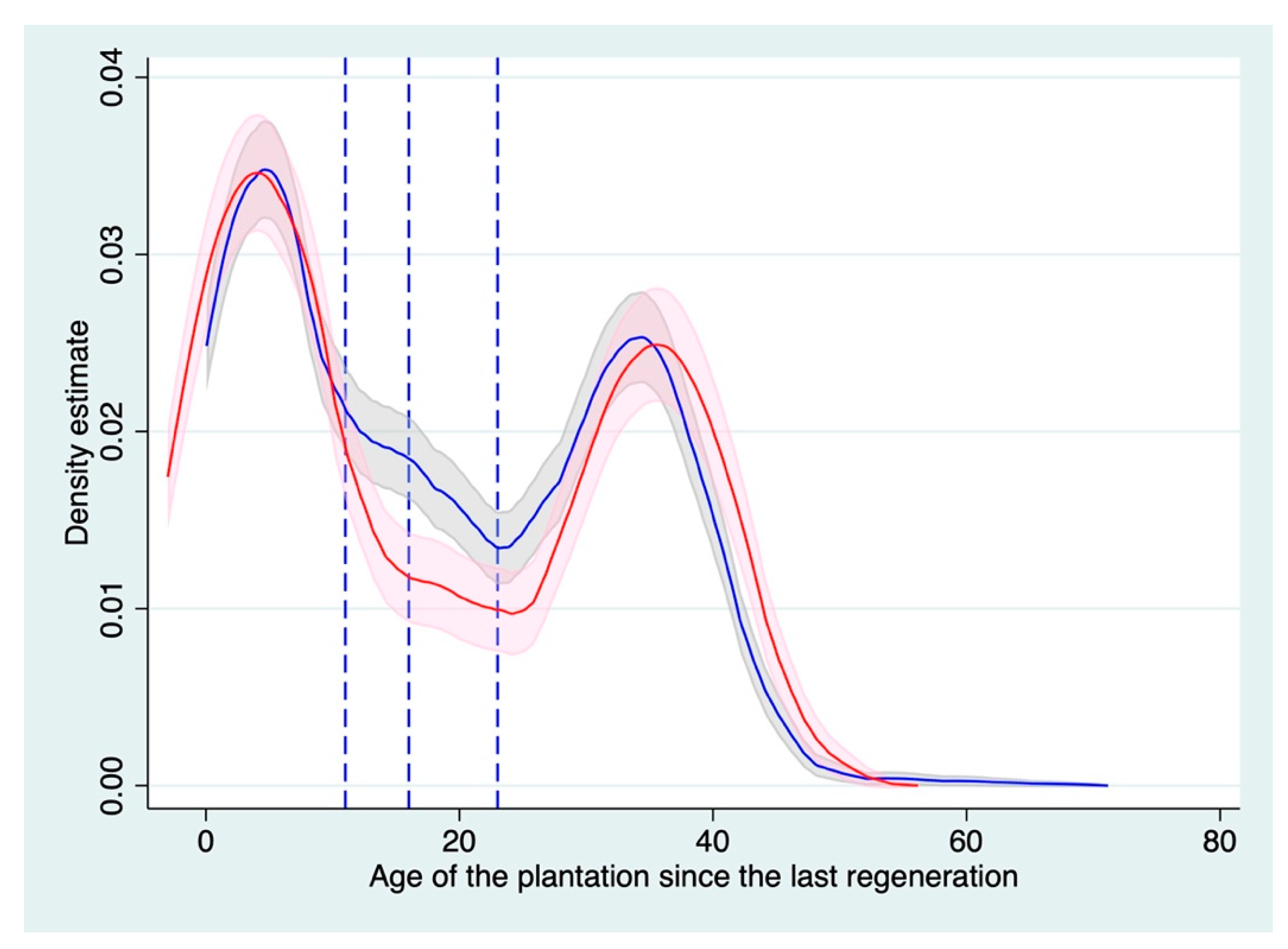
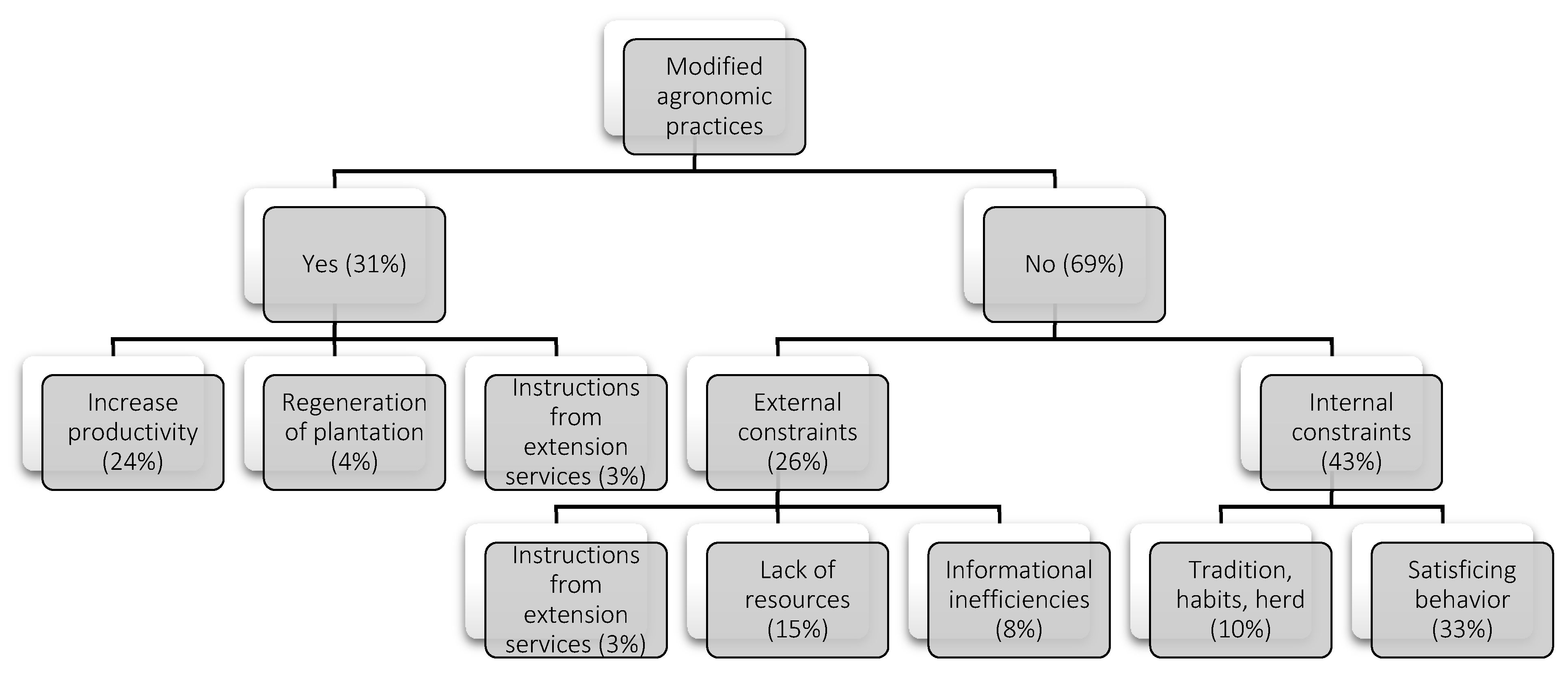
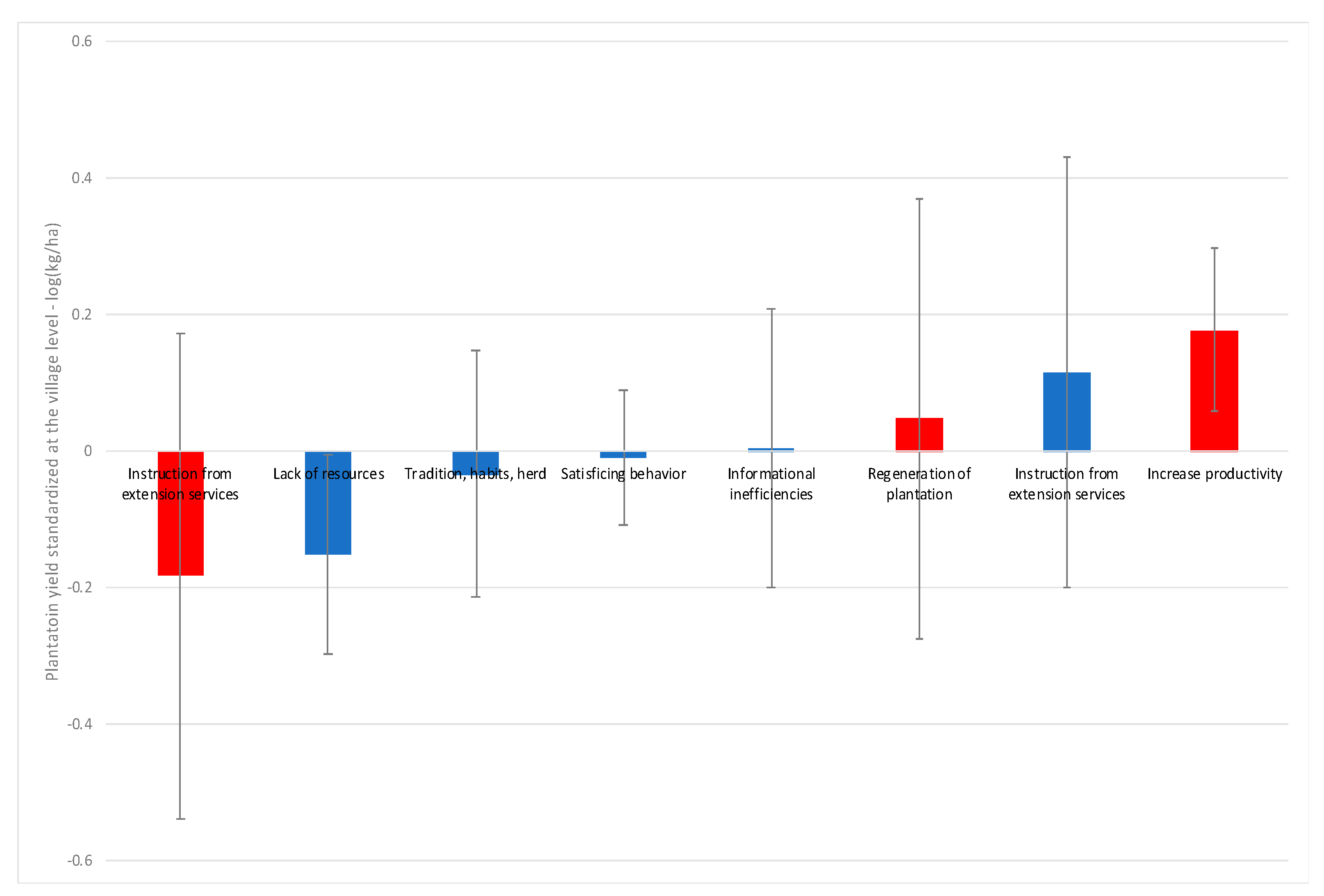

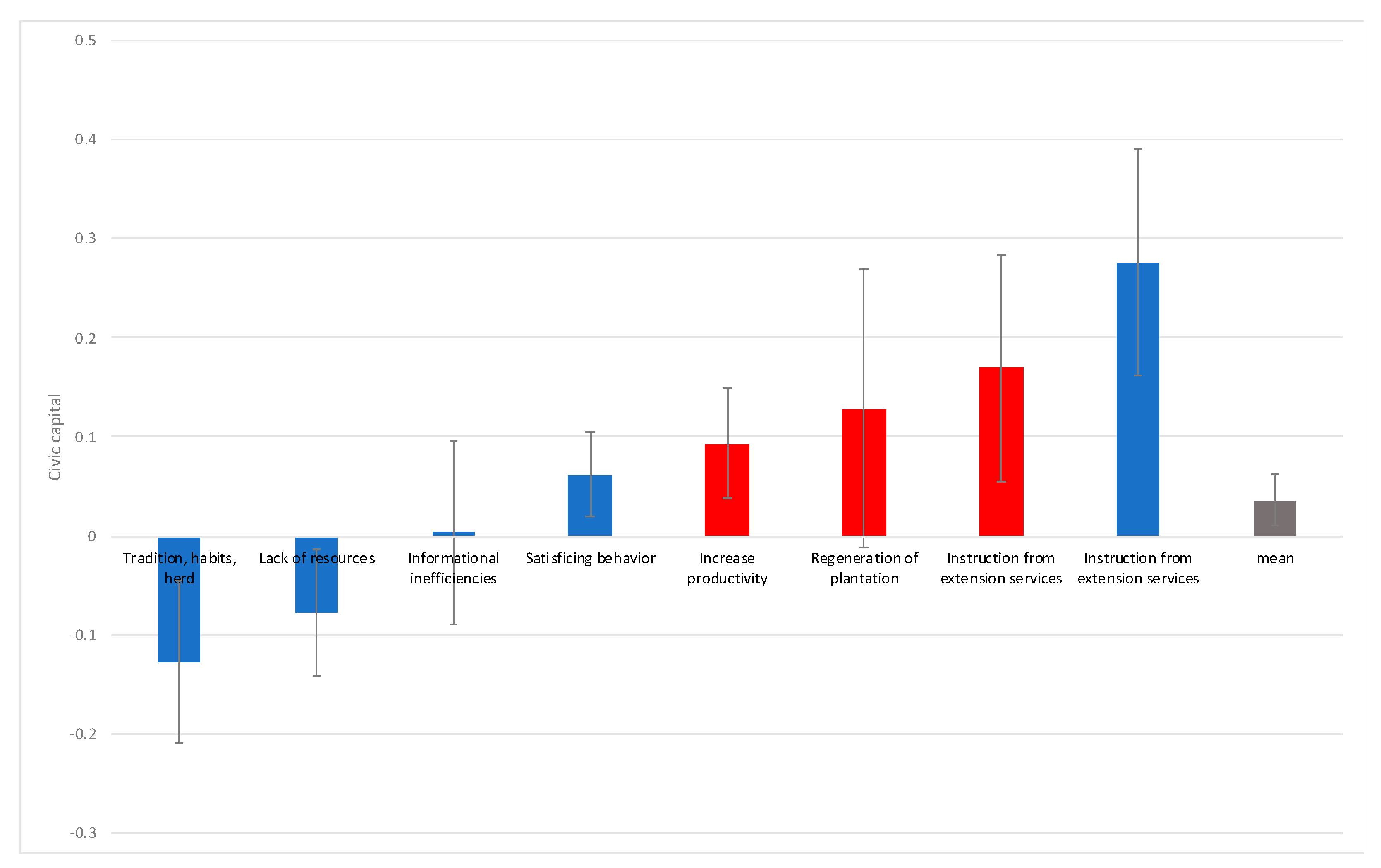
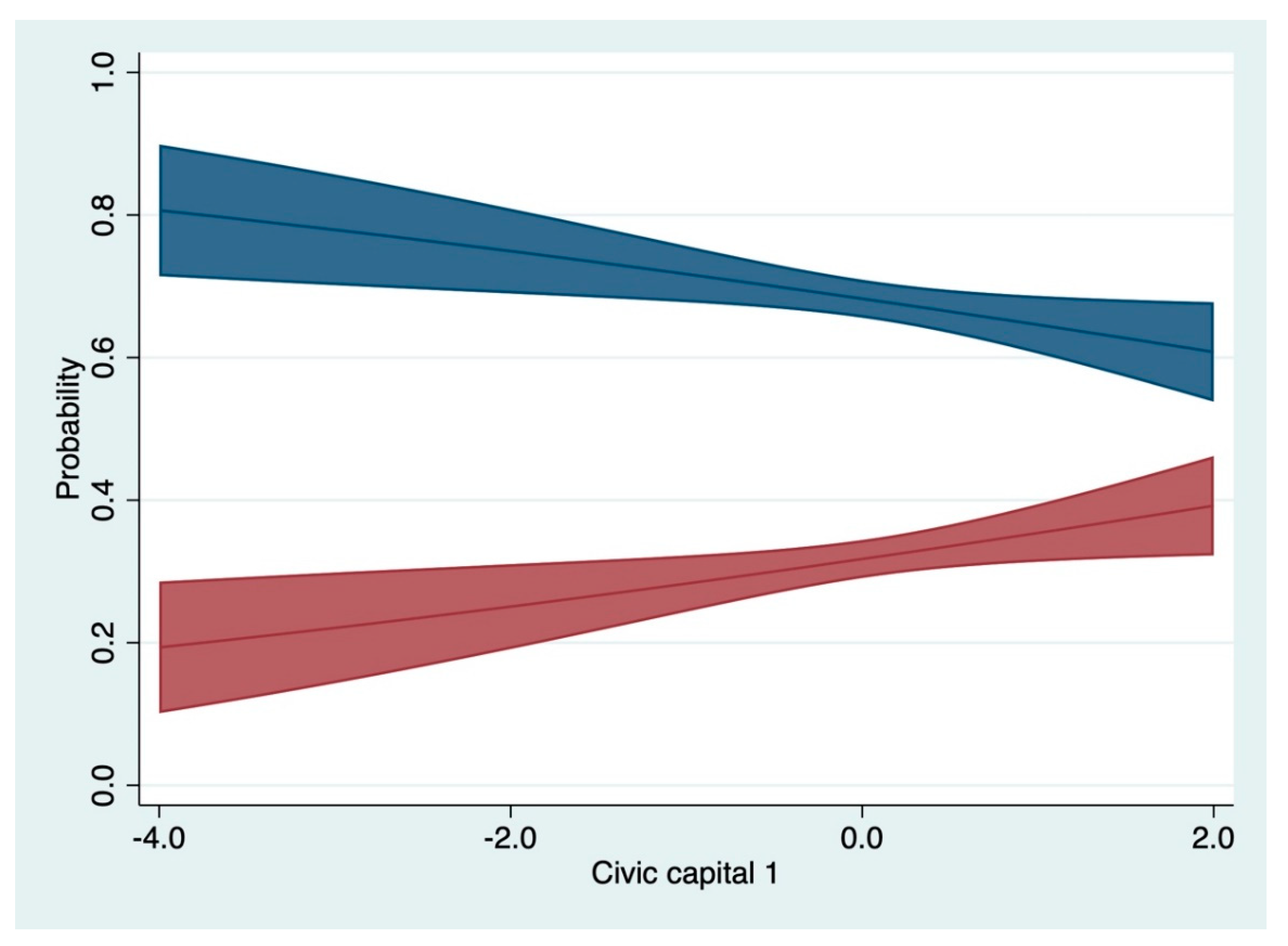
| Modification of Agricultural Practices | ||||||
|---|---|---|---|---|---|---|
| Paths of Productivity Growth | No | Yes | Total | |||
| Increased | 64.37% | 35.63% | 100% | |||
| n = 261 | 19.20% | 24.09% | - | 20.70% | ||
| Steady | 71.38% | 28.62% | 100% | |||
| n = 919 | 74.97% | 68.13% | - | 72.88% | ||
| Decreased | 62.96% | 37.04% | 100% | |||
| n = 81 | 5.83% | 7.77% | - | 6.42% | ||
| Total | 100% | 100% | 100% | |||
| n = 1261 | ||||||
| Farmer’s Characteristics | No (%) | Chi2 |
| Origins | ||
| Indigenous resident | 86.1 | n = 1262 *** |
| Internal migrant | 63.7 | |
| External migrant | 71.6 | |
| Age (quartile) | ||
| <33 | 68.6 | n = 1262 H0 |
| (33–42) | 70.4 | |
| (43–53) | 71.1 | |
| >53 | 67.1 | |
| Education | ||
| Schooling | 69.2 | n = 1262 H0 |
| No schooling | 69.6 | |
| Administration rights | ||
| Yes | 67.6 | n = 1262 *** |
| No | 76.2 | |
| Born in village | ||
| Yes (24%) | 74.8 | n = 1262 ** |
| No (76%) | 67.7 | |
| Plantation characteristics | No (%) | Chi2 |
| Size (quartile) | ||
| ≤2 ha | 75.2 | n = 1262 ** |
| )2–3) ha | 67.0 | |
| )3–5) ha | 68.6 | |
| >5 ha | 65.0 | |
| Yield (quartile) | ||
| ≤240 kg/ha | 75.3 | n = 1262 *** |
| )240–400) kg/ha | 71.0 | |
| )400–570) kg/ha | 71.5 | |
| >570 kg/ha | 59.6 |
| Civic Capital Space | Axis 1 (54%) | Axis 2 (20%) |
|---|---|---|
| Solidarity | Contribution | Contribution |
| If a community project does not directly benefit your neighbor but has benefits for others in the village, then do you think your neighbor would contribute time for this project? | 0.0774 | 0.0066 |
| If a community project does not directly benefit your neighbor but has benefits for others in the village, then do you think your neighbor would contribute money for this project? | 0.0795 | 0.0197 |
| If I have a problem, there is always someone to help me. | 0.0692 | 0.1479 |
| Most people in this village are willing to help if you need it. | 0.0861 | 0.1460 |
| If you lose an animal, someone in the village would help look for it or would return it to you. | 0.0473 | 0.0938 |
| Overall, how do you rate the spirit of participation, i.e., the willingness and propensity to participate and be useful, in this village? | 0.0378 | 0.0311 |
| Total | 0.3973 | 0.4451 |
| Reciprocity | ||
| Do most adults in this community work hard? That is, are most people self-reliant and disciplined? | 0.0068 | 0.0713 |
| To what extent do most people in this community believe that they are responsible for their own words and actions? | 0.0748 | 0.0484 |
| If people in this village violate social norms, e.g., insults, rubbish someone, stealing, do they try to remedy their moral transgressions? | 0.0735 | 0.0407 |
| People are always interested only in their own welfare. | 0.0828 | 0.0134 |
| I do not pay attention to the opinions of others in the village. | 0.0523 | 0.0339 |
| Total | 0.2902 | 0.2077 |
| Trustworthiness | ||
| Do you think that in this village people generally trust one another in matters of lending and borrowing? | 0.0621 | 0.0298 |
| Most people in this village are basically honest and can be trusted. | 0.0786 | 0.0907 |
| In this village, one has to be alert or someone is likely to take advantage of you. | 0.0291 | 0.0071 |
| Total | 0.1698 | 0.1277 |
| Cooperation | ||
| Over the past three years, how many times has the village community taken collective action with administrative authorities and elected politicians to develop the village? | 0.0271 | 0.0413 |
| For the steps whose outcome is known today, have they achieved the expected result? | 0.0108 | 0.0102 |
| Have you been solicited by anyone in the last three years to participate in a class action? | 0.0400 | 0.0559 |
| How many times have you yourself participated in a collective action with other villagers in the past three years? | 0.0502 | 0.0878 |
| If so, did these actions concern the improvement of the village’s infrastructure? | 0.0146 | 0.0244 |
| Total | 0.1427 | 0.2195 |
| Axis 1 | Contribution (%) | Axis 2 | Contribution (%) |
|---|---|---|---|
| Solidarity | 39.7% | Solidarity | 44.5% |
| Reciprocity | 29.0% | Cooperation | 22.0% |
| Trustworthiness | 17.0% | Reciprocity | 20.8% |
| Cooperation | 14.3% | Trustworthiness | 12.8% |
| Total | 100% | Total | 100% |
| Group Membership n = 1137, 90% | Group 1 n = 1137 | Group 2 n = 488 |
|---|---|---|
| Agricultural organization | 67% | 19% |
| Religious organization | 13% | 14% |
| Diaspora | 6% | 30% |
| Youth/Women’s group | 4% | 9% |
| Family group | 3% | 9% |
| Other (e.g., traditional chiefdoms) | 7% | 19% |
| Exchange of Personal Information | Agricultural Information Exchange and Learning | |||
|---|---|---|---|---|
| Group 1 “Yes” | Group 2 “Yes” | Group 1 “Yes” | Group 2 “Yes” | |
| Agricultural organization | 42% | 45% | 91% | 75% |
| Religious organization | 75% | 73% | 41% | 28% |
| Youth/Women’s group | 70% | 91% | 30% | 40% |
| Family group | 100% | 95% | 46% | 24% |
| Diaspora | 88% | 94% | 30% | 23% |
| Other | 77% | 80% | 45% | 39% |
| Obs. | 608/1116 | 379/480 | 821/1116 | 184/480 |
| Chi2 (p-value) | 0.00 | 0.00 | 0.00 | 0.00 |
|
Dependent Variable: Modifying Farming Practices over the Past Two Years | |||
|---|---|---|---|
| Independent Variables: Smallholder Social Capital | (1) | (2) | (3) |
| Civic capital—axis 1 | 0.173 (0.077) ** | 0.167 (0.077) ** | 0.182 (0.079) ** |
| Civic capital—axis 2 | 0.089 (0.068) | 0.093 (0.068) | 0.110 (0.069) |
| Agricultural organization | 0.091 (0.171) | - | - |
| # Group memberships | 0.326 (0.076) *** | 0.319 (0.076) *** | 0.311 (0.077) *** |
| Member’s duration | 0.009 (0.012) | 0.007 (0.012) | 0.012 (0.012) |
| Youth/Women’s group | −0.545 (0.390) | ||
| Family group | −0.153 (0.501) | ||
| Diaspora | −0.129 (0.327) | ||
| Other (e.g., chiefs) | 0.290 (0.301) | ||
| Personal information | −0.043 (0.158) | ||
| Agricultural information | 0.332 (0.182) * | ||
| Smallholder’s characteristics | |||
| Internal migrant | 0.716 (0.383) * | 0.787 (0.385) ** | 0.705 (0.383) * |
| External migrant | 0.726 (0.385) * | 0.726 (0.386) * | 0.625 (0.386) |
| Age | −0.022 (0.030) | −0.022 (0.030) | −0.030 (0.031) |
| Age2 | 0.000 (0.000) | 0.000 (0.000) | 0.000 (0.000) |
| Born in village (No) | −0.249 (0.210) | −0.270 (0.211) | −0.313 (0.214) |
| Education (No schooling) | 0.030 (0.156) | 0.030 (0.156) | −0.004 (0.159) |
| Administration rights (No) | 0.404 (0.190) ** | 0.402 (0.189) ** | 0.384 (0.193) ** |
| Household size | −0.028 (0.018) | 0.030 (0.018) | −0.025 (0.018) |
| # Males (≥18) in agriculture | 0.142 (0.062) ** | 0.143 (0.061) ** | 0.144 (0.063) ** |
| Plantation’s characteristics | |||
| Plant. Size: )2–3) ha | 0.132 (0.200) | 0.138 (0.202) | 0.112 (0.202) |
| Plant. Size: )3–5) ha | −0.171 (0.213) | −0.163 (0.213) | −0.163 (0.216) |
| Plant. Size: >5 ha | −0.064 (0.206) | −0.057 (0.206) | −0.093 (0.209) |
| Plantation age | −0.045 (0.020) ** | −0.045 (0.020) ** | −0.047 (0.021) ** |
| Plantation age2 | 0.001 (0.000) ** | 0.001 (0.000) ** | 0.001 (0.001) ** |
| Observations | 1093 | 1093 | 1074 |
| Log-likelihood value | −631.244 | −629.613 | −615.802 |
| Chi2 (p-value) | 0.000 *** | 0.000 *** | 0.000 *** |
| Village FE—Chi2 (p-value) | 0.113 | 0.069 * | 0.115 |
Publisher’s Note: MDPI stays neutral with regard to jurisdictional claims in published maps and institutional affiliations. |
© 2021 by the authors. Licensee MDPI, Basel, Switzerland. This article is an open access article distributed under the terms and conditions of the Creative Commons Attribution (CC BY) license (https://creativecommons.org/licenses/by/4.0/).
Share and Cite
Cordaro, F.; Desdoigts, A. Bounded Rationality, Social Capital and Technology Adoption in Family Farming: Evidence from Cocoa-Tree Crops in Ivory Coast. Sustainability 2021, 13, 7483. https://doi.org/10.3390/su13137483
Cordaro F, Desdoigts A. Bounded Rationality, Social Capital and Technology Adoption in Family Farming: Evidence from Cocoa-Tree Crops in Ivory Coast. Sustainability. 2021; 13(13):7483. https://doi.org/10.3390/su13137483
Chicago/Turabian StyleCordaro, Francesco, and Alain Desdoigts. 2021. "Bounded Rationality, Social Capital and Technology Adoption in Family Farming: Evidence from Cocoa-Tree Crops in Ivory Coast" Sustainability 13, no. 13: 7483. https://doi.org/10.3390/su13137483





